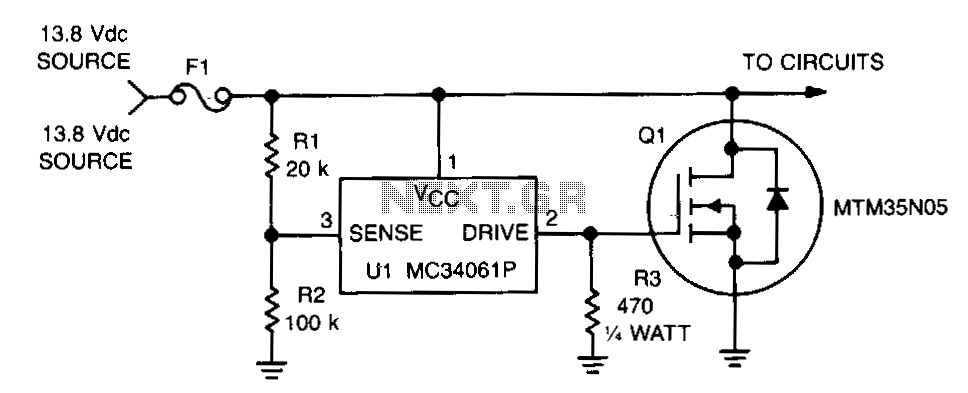
Fast-overvoltage-protector

This circuit protects expensive portable equipment against all types of improper hookups and environmental hazards that could cause an overvoltage condition. It operates very quickly and does not latch up; rather, it recovers when the overvoltage condition is removed. In contrast, SCR overvoltage circuits can latch and do not recover unless the power is removed. Here, U1 senses an overvoltage condition when the drop across R1 exceeds 2.5 V. This causes U1 to apply a positive signal to the gate of Q1, turning it on and shorting the line going to the external circuits. Fuse 1 opens if the transient condition lasts long enough to exceed the i²t rating.
This circuit is designed as a protective measure for sensitive electronic devices, ensuring their safety from overvoltage scenarios that may arise from improper connections or environmental factors. The operation begins with the voltage sensing component, U1, which is typically a voltage comparator or operational amplifier configured to monitor the voltage across resistor R1. When the voltage drop across R1 reaches a threshold of 2.5 V, U1 triggers a response.
Upon detecting an overvoltage condition, U1 sends a positive signal to the gate of transistor Q1. This transistor is configured as a switch in the circuit. When Q1 is turned on, it creates a low-resistance path to ground, effectively shorting the output line that connects to the external circuits. This action diverts the excess voltage away from the sensitive components, thereby preventing potential damage.
In addition to the active components, the circuit incorporates Fuse 1, which serves as a safety feature. The fuse is designed to open and disconnect the circuit if the overvoltage condition persists long enough to exceed its i²t rating. This ensures that even in the case of a prolonged overvoltage event, the circuit will protect the connected equipment by breaking the circuit and preventing further damage.
Overall, this overvoltage protection circuit is characterized by its fast response time and automatic recovery capability, distinguishing it from other protection methods, such as SCR-based circuits, which require a power cycle to reset. The design emphasizes reliability and efficiency, making it suitable for use in various portable electronic devices where overvoltage conditions may occur.This circuit protects expensive portable equipment against all types of improper hookups and environmental hazards that could cause an overvoltage condition. It operates very quickly and does not latchup, that is, it recovers when the overvoltage condition is removed.
In contrast, SCR overvoltage circuits can latch and do not recover, unless the power is removed. Here, Ul senses an overvoltage condition when the drop across Rl exceeds 2.5 V. This causes Ul to apply a positive signal to the gate of Ql, turning it on and shorting the line going to the external circuits. Fuse 1 opens if the transient condition lasts long enough to exceed the i 2t rating. 🔗 External reference
This circuit is designed as a protective measure for sensitive electronic devices, ensuring their safety from overvoltage scenarios that may arise from improper connections or environmental factors. The operation begins with the voltage sensing component, U1, which is typically a voltage comparator or operational amplifier configured to monitor the voltage across resistor R1. When the voltage drop across R1 reaches a threshold of 2.5 V, U1 triggers a response.
Upon detecting an overvoltage condition, U1 sends a positive signal to the gate of transistor Q1. This transistor is configured as a switch in the circuit. When Q1 is turned on, it creates a low-resistance path to ground, effectively shorting the output line that connects to the external circuits. This action diverts the excess voltage away from the sensitive components, thereby preventing potential damage.
In addition to the active components, the circuit incorporates Fuse 1, which serves as a safety feature. The fuse is designed to open and disconnect the circuit if the overvoltage condition persists long enough to exceed its i²t rating. This ensures that even in the case of a prolonged overvoltage event, the circuit will protect the connected equipment by breaking the circuit and preventing further damage.
Overall, this overvoltage protection circuit is characterized by its fast response time and automatic recovery capability, distinguishing it from other protection methods, such as SCR-based circuits, which require a power cycle to reset. The design emphasizes reliability and efficiency, making it suitable for use in various portable electronic devices where overvoltage conditions may occur.This circuit protects expensive portable equipment against all types of improper hookups and environmental hazards that could cause an overvoltage condition. It operates very quickly and does not latchup, that is, it recovers when the overvoltage condition is removed.
In contrast, SCR overvoltage circuits can latch and do not recover, unless the power is removed. Here, Ul senses an overvoltage condition when the drop across Rl exceeds 2.5 V. This causes Ul to apply a positive signal to the gate of Ql, turning it on and shorting the line going to the external circuits. Fuse 1 opens if the transient condition lasts long enough to exceed the i 2t rating. 🔗 External reference
Warning: include(partials/cookie-banner.php): Failed to open stream: Permission denied in /var/www/html/nextgr/view-circuit.php on line 713
Warning: include(): Failed opening 'partials/cookie-banner.php' for inclusion (include_path='.:/usr/share/php') in /var/www/html/nextgr/view-circuit.php on line 713